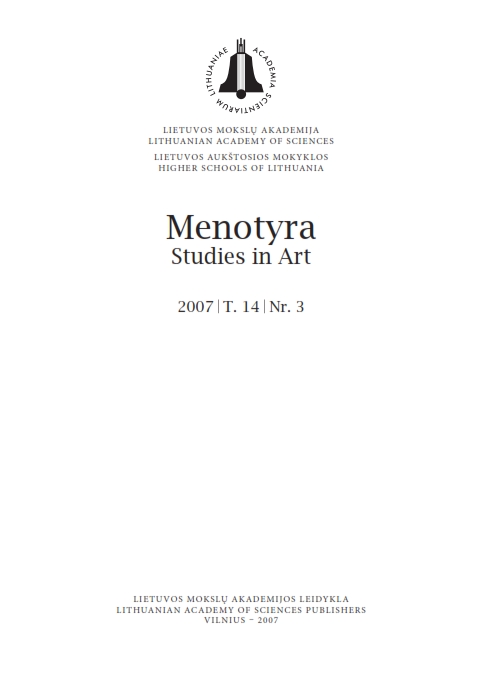XIX a. pabaigos–XX a. I pusės meninių judėjimų įtaka studijinio stiklo susiformavimui ir raidai
Influence of artistic movements (late 19th–early 20th c.) on formation and development of studio glass
Author(s): Raimonda Kogelytė-SimanaitienėSubject(s): Cultural history, Visual Arts, 19th Century, Pre-WW I & WW I (1900 -1919)
Published by: Lietuvos mokslų akademijos leidykla
Summary/Abstract: The article offers an analysis of the influence of modern trends on contemporary glass art development. The first part analyses the aesthetic conception of art of English theorist W. Morris (1834–1896) who had a considerable influence on the development of applied arts in the 20th century and specifically on the development of artistic glass during the art nouveau and art deco periods. His thoughts about the artistry of applied arts and individual approach to creation were important for the further development of glass industry. The excesses of Victorian glass–epitomized by the giant exhibition pieces smothered in gilding and colour and cut with thousands of shimmering facets – were already condemned by contemporary critics. Out of this antipathy toward the mechanical production of the Industrial Revolution grew a desire to return to more natural sources. The revolutionary effect on design following the opening up of Japan to the West and the publication of pattern books illustrating ornaments from around the world, aided by theorists such as W. Morris advocating the role of the craftsman, led to the evolution of a completely new style, art nouveau. The terms “art nouveau” and “Arts and Crafts” are generally used to describe a multitude of different decorative styles which emerged in Europe and the United States in the 1880s, peaking around 1910. Themotifsemployed–usuallynaturalforms–werelargelytreatedinanun-realistic manner, arranged either in asymmetrical compositions of swirling curves or in more rigid patterns of simplified, sometimes almost geometric shapes. In most cases, there is a marked tendency toward abstraction, and often the subject, whether plant, bird, animal or human figure, is more or less unrecognizable. The glassmaker E. Galle (1846–1904) established his own glasshouse in Nancy and in the 1880s became the central figure of not only the School of Nancy, designing furniture, faience and glass, but of the whole art nouveau style. Even a more multi-media master than E. Galle, L. C. Tiffany (1848–1933) turned a well-stocked imagination to interior design: no material escaped his transforming influence, especially glass. The next major early-twentieth-century modernist figure in glass was M. Marinot (1882–1960) who experienced an instant passion for the material of glass in 1911 during his visit to the Viard glassworks at Bar-sur-Seine, France. Initially he learned the glasses blown from a Viard gaffer, but soon he began to approach glass as a sculptor concerned with its body and form.W. Morris’ aesthetics remain relevant after the Second World War when in the USA, and after wards in the whole Europe, the studio glass movement was formed in the 60s and 70s, which helped the artists to dissociate from the glass industry. D. Labino (1910–1987) became one of the pioneer studio glass artists specializing in pieces with subtle colour effects. H. Littleton (b.1922) has made abstract sculptural pieces, some of them designed as ironic comments on the functionalist’s prejudice against purely artistic values. During the 1960s the studio glass movement gathered momentum and reached many countries in Europe. This movement changed the development of artistic glass towards more figurative and anti-utilitarian representation, and it based individual and author’s approach towards the creation of artistic glass. In the 90s, this movement reached the Baltic States including Lithuania. Appearance of glass studios in our country encouraged a more active development of artistic glass-working in Lithuania.
Journal: Menotyra
- Issue Year: 14/2007
- Issue No: 3
- Page Range: 32-42
- Page Count: 11
- Language: Lithuanian

